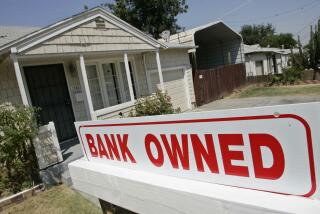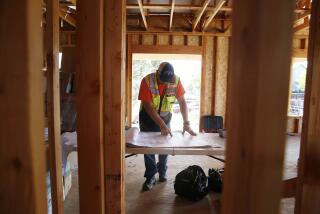HUD OKs Some 3% Down Payments
WASHINGTON — While Congress and the White House negotiate, almost ad nauseam, on matters of budget cutting or revenue enhancement, first-time prospective home buyers hav ben given a slightly more favorable financial climate in which to become mortgage-paying owners using FHA financing.
That’s because the Department of Housing and Urban Development has authorized lower down payments on dwellings priced at $50,000 or less. New single-family houses are impossible to find in that low price bracket but renters eager to become first-time owners often will embrace small converted condominium apartments or older town houses in cities or towns.
The change that requires only a 3% down payment on dwellings priced under $50,000, lowers the minimum down payment on that price dwelling by $500.
“Because a higher loan-to-value ratio means the purchaser needs a smaller minimum down payment, this amendment will help those persons traditionally served by FHA--home buyers with sound credit and income and strong motivation to support mortgage debt but with a limited amount of liquid assets to provide a larger down payment,” Brian Chappelle of HUD, explained.
Further Relaxations
The HUD official said that the easier credit program for lower-income home buyers would be monitored to learn if the program proves successful in widening home-buying opportunities without causing more mortgage defaults. If the results are positive, FHA lending restrictions might be further relaxed, Chappelle added.
Changing the down payment formula also means that the loan amount will be slightly larger, and thus the monthly mortgage payment will be an estimated $5 more under an interest rate of 11 1/2%. Buyers who do not plan to live in the houses that are purchased with FHA financing will not be granted the lower down-payment incentive.
Meanwhile, Sen. Robert Packwood (R-Ore.) has promised to do something about some disturbing inequities in the Reagan Administration’s tax proposal.
On one hand the Reagan package focuses on lowering tax rates for individuals while also increasing the amount of income subject to tax in order to avoid loss of revenue. Also, some deductions would be eliminated or restricted along with other tax preferences.
Mismatched Dates
But Burton Wood, senior staff lobbyist for the Mortgage Bankers Assn., pointed out recently that the Reagan Treasury proposal mismatched the effective dates for those proposed changes. While most base-broadening provisions would be effective Jan. 1, 1986, the marginal tax rate deductions would not be effective until July 1, 1986.
Wood noted that this means a larger tax base would be taxed at current rates for half of 1986--thus cutting in half the tax benefit associated with lower marginal rates for 1986.
As Wood sees it, the delayed reduction of marginal tax rates and the impact of base-broadening on middle-income homeowners, those people might wind up with less disposable income than they might be led to anticipate. Coupled with the loss of the deductibility of state and local property taxes, this could make homeownership more expensive for many millions of Americans.
MBA’s economic analysts came up with a projection showing that an average increase in after-tax cost of the first year of homeownership would rise 9% to 19%, depending on household income levels.
Unlike the FHA move to reduce down-payment requirements for first-time buyers, these tax changes would make homeownership more expensive for young couples and persons trying to avoid the prospects of higher rents under new tax laws.
More to Read
Inside the business of entertainment
The Wide Shot brings you news, analysis and insights on everything from streaming wars to production — and what it all means for the future.
You may occasionally receive promotional content from the Los Angeles Times.










